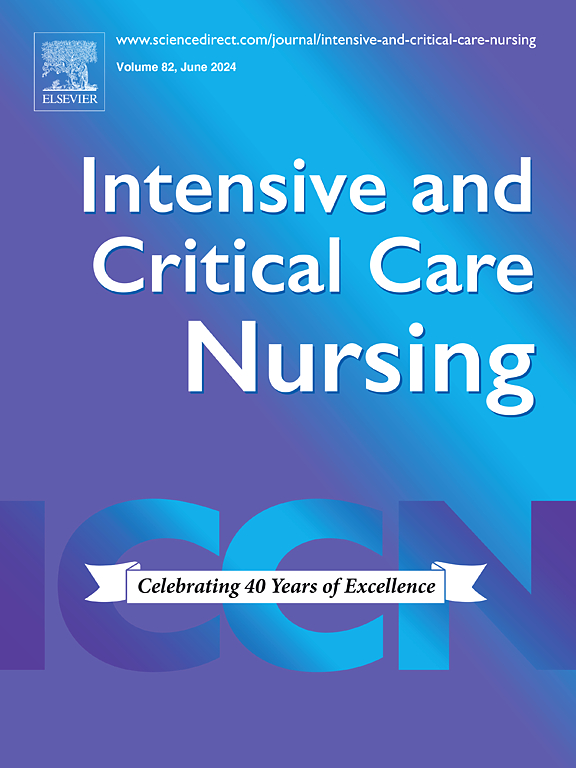Effectiveness of non-pharmacological interventions for pain reduction following chest tube removal: A systematic review and network meta-analysis
IF 4.9
2区 医学
Q1 NURSING
引用次数: 0
Abstract
Objective
This study aimed to determine the most effective non-pharmacological intervention for pain relief following chest tube removal in adult patients.
Methods
We performed a systematic review with network meta-analysis, searching electronic databases for randomized controlled trials up to January 20, 2024. Compared to control or placebo groups, the trials included adult patients receiving non-pharmacological interventions, such as cold therapy, relaxation exercises, music therapy, transcutaneous electrical nerve stimulation, or aromatherapy. Data analysis utilized a random-effects model, reporting standardized mean differences (SMD) with 95% confidence intervals (CI), and treatment ranking was determined through surface under the cumulative ranking analysis and forest plots.
Results
Sixteen studies enrolling 1,342 patients were included, with moderate to high heterogeneity. Cold therapy and relaxation exercises effectively reduced pain after chest tube removal, with SMD of −1.84 (95 % CI: −2.81 to −0.87) and −2.04 (95 % CI: −3.43 to −0.65), respectively, from baseline to immediately post-removal. From baseline to ten to twenty minutes after removal, both therapies continued to show significant pain reduction, with SMD of −1.96 (95 % CI: −3.14 to −0.77) for cold therapy and −2.01 (95 % CI: −3.75 to −0.28) for relaxation exercises. Sensitivity analysis supported these findings, and cold therapy’s efficacy appeared unaffected by obesity. However, publication bias, possibly due to small study samples, was noted.
Conclusions
Cold therapy and relaxation exercises proved most effective for reducing pain immediately and up to ten to twenty minutes after chest tube removal. Given their cost-effectiveness, lack of side effects, and ease of use, we recommend relaxation exercises as a practical alternative to cold therapy. Nonetheless, further studies are needed to comprehensively assess non-pharmacological options for managing chest tube removal pain.
Implications for clinical practice
Incorporate cold therapy and relaxation exercises into post-chest tube removal pain management to improve patient comfort and minimize reliance on pharmacological interventions.
非药物干预对胸管拔除后疼痛减轻的有效性:系统回顾和网络荟萃分析
目的探讨成人患者胸管拔除后疼痛的最有效非药物干预方法。方法采用网络荟萃分析方法,检索截至2024年1月20日的随机对照试验电子数据库,进行系统评价。与对照组或安慰剂组相比,试验包括接受非药物干预的成年患者,如冷疗法、放松练习、音乐疗法、经皮神经电刺激或芳香疗法。数据分析采用随机效应模型,报告95%可信区间(CI)的标准化平均差异(SMD),并在累积排序分析和森林样地下通过表面确定处理等级。结果纳入16项研究,共1342例患者,异质性中等至高度。冷疗法和放松练习有效地减轻了胸管取出后的疼痛,从基线到取出后立即,SMD分别为- 1.84 (95% CI: - 2.81至- 0.87)和- 2.04 (95% CI: - 3.43至- 0.65)。从基线到移除后10到20分钟,两种疗法都继续显示出显著的疼痛减轻,冷疗法的SMD为- 1.96 (95% CI: - 3.14至- 0.77),放松练习的SMD为- 2.01 (95% CI: - 3.75至- 0.28)。敏感性分析支持这些发现,冷疗法的疗效似乎不受肥胖的影响。然而,可能由于研究样本小,发表偏倚也被注意到了。结论:胸腔管拔除后10 ~ 20分钟内,胸腔管拔除后10 ~ 20分钟内,胸腔管拔除后疼痛的缓解效果最好。考虑到它们的成本效益,缺乏副作用,并且易于使用,我们推荐放松练习作为冷疗法的实用替代方案。尽管如此,需要进一步的研究来全面评估治疗胸管拔管疼痛的非药物选择。对临床实践的启示:将冷疗法和放松练习纳入胸管拔管后疼痛管理,以提高患者舒适度,减少对药物干预的依赖。
本文章由计算机程序翻译,如有差异,请以英文原文为准。
求助全文
约1分钟内获得全文
求助全文
来源期刊

Intensive and Critical Care Nursing
NURSING-
CiteScore
6.30
自引率
15.10%
发文量
144
审稿时长
57 days
期刊介绍:
The aims of Intensive and Critical Care Nursing are to promote excellence of care of critically ill patients by specialist nurses and their professional colleagues; to provide an international and interdisciplinary forum for the publication, dissemination and exchange of research findings, experience and ideas; to develop and enhance the knowledge, skills, attitudes and creative thinking essential to good critical care nursing practice. The journal publishes reviews, updates and feature articles in addition to original papers and significant preliminary communications. Articles may deal with any part of practice including relevant clinical, research, educational, psychological and technological aspects.
 求助内容:
求助内容: 应助结果提醒方式:
应助结果提醒方式:


